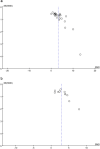Preclinical efficacy of stem cell therapy for skin flap: a systematic review and meta-analysis
- PMID: 33413598
- PMCID: PMC7791712
- DOI: 10.1186/s13287-020-02103-w
Preclinical efficacy of stem cell therapy for skin flap: a systematic review and meta-analysis
Abstract
Background: A skin flap is one of the most critical surgical techniques for the restoration of cutaneous defects. However, the distal necrosis of the skin flap severely restricts the clinical application of flap surgery. As there is no consensus on the treatment methods to prevent distal necrosis of skin flaps, more effective and feasible interventions to prevent skin flaps from necrosis are urgently needed. Stem therapy as a potential method to improve the survival rate of skin flaps is receiving increasing attention.
Methods: This review followed the recommendations from the Preferred Reporting Items for Systematic Reviews and Meta-Analysis (PRISMA) statements. Twenty studies with 500 animals were included by searching Web of Science, EMBASE, PubMed, and Cochrane Library databases, up until October 8, 2020. Moreover, the references of the included articles were searched manually to obtain other studies. All analyses were conducted using Review Manager V.5.3 software.
Results: Meta-analysis of all 20 studies demonstrated stem cell treatment has significant effects on reducing necrosis of skin flap compared with the control group (SMD: 3.20, 95% CI 2.47 to 3.93). Besides, subgroup analysis showed differences in the efficacy of stem cells in improving the survival rate of skin flaps in areas of skin flap, cell type, transplant types, and method of administration of stem cells. The meta-analysis also showed that stem cell treatment had a significant effect on increasing blood vessel density (SMD: 2.96, 95% CI 2.21 to 3.72) and increasing the expression of vascular endothelial growth factor (VEGF, SMD: 4.34, 95% CI 2.48 to 6.1).
Conclusions: The preclinical evidence of our systematic review indicate that stem cell-based therapy is effective for promoting early angiogenesis by up regulating VEGF and ultimately improving the survival rate of skin flap. In summary, small area skin flap, the administration method of intra-arterial injection, ASCs and MSCs, and xenogenic stem cells from humans showed more effective for the survival of animal skin flaps. In general, stem cell-based therapy may be a promising method to prevent skin flap necrosis.
Keywords: Meta-analysis; Preclinical evidence; Skin flaps; Stem cell.
Conflict of interest statement
The authors declare that they have no competing interests.
Figures





References
Publication types
MeSH terms
Substances
LinkOut - more resources
Full Text Sources
Other Literature Sources
Research Materials

